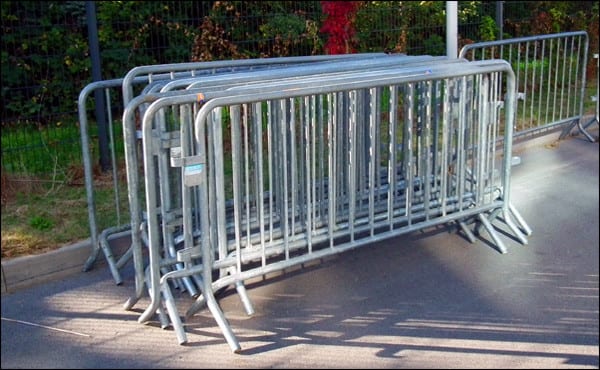
It’s the day of your big event. Everything is set and all systems are go! The line to get in is getting longer, and longer - is your crowd safety policy up to the task? The time to review the best practices in crowd safety is preemptively, long before the event start date. To help you, this post looks at how other venues comply with city code and provides a safety checklist.
How Safe Is Your Venue?
Today, the NBC affiliate in Chicago published a follow-up on an 2011 investigative report. The investigation is centered around an injury suffered by a nightclub patron after a section of the ceiling fell during a concert.
Since the time of the incident, the venue has complied with regulations resulting in city inspectors deeming it safe. But, as the NBC5 follow-up report states, the patron injured has her reservations and says she will not be returning to the venue anytime soon.
The report quotes a structural engineer familiar with crowd safety inspections, about the need for immediate action to be taken a venue once an issue is known to exist:
If a ceiling fails, it’s a warning sign about other parts of the ceiling [and the] building owners have a responsibility to fix it immediately. Once you have danger warnings you need to schedule an inspection with a qualified engineering firm or architectural firm and examine it inch by inch.
The long term concern for the nightclub in Chicago, as well as all other venues, is the public’s perception as it relates to future events. If patrons are talking to their friends about how they were hurt at an event, a stigma can flourish and become a persuasive opinion - even after the venue has addressed an issue and is in full compliance with all code requirements. Retroactive repair of public perception ultimately becomes a cost that can exceed the original repairs and permitting.
Rather than face the expense that goes into ensuring a venue is safe after an incident has already occurred, venues can voluntarily initiate an audit using established best practices in crowd safety.
Underwriting To Help With Compliance
In Iowa City, Iowa, city officials have recognized tragic lessons to be learned from the recent fire at the Kiss nightclub in Brazil. In a proactive effort, Iowa City has hastened code compliance for local venues.
Acknowledging the costs an accelerated compliance schedule may cause small businesses, the city has made underwriting available. The funds come with some restrictions, but the majority of venues have taken advantage of the city funding. Allie Ryan writes in the Daily Iowan:
The Iowa City City Council approved the Fire/Life-Safety Improvement Loan Program in July 2007, which supplies grants and low-interest loans to local bars and restaurants to assist them in financing the installments of sprinkler systems and fire alarms. The program provided $1 million, which was borrowed from the city’s Landfill Division, on a first-come, first-served basis, to eligible businesses.
Venues owners nationwide are encouraged to find out if their city is offering underwriting for safety improvements and/or code compliance. The municipal funds may not have been formally announced, leaving small business owners unaware of the cost savings to be had. Note that in Iowa City, the fire sprinkler code requirements call for for high pressure water lines. The Iowa City water district was offering a discounted installation price for venues needing the higher pressure line.
Best Practices In Crowd Safety Checklist
In 2003, one of the worst nightclub disasters in Chicago's history occurred after a venue security guard pepper spray to break up a fight. The dense crowd felt the effects of the pepper spray and began to panic and rushed for the exits, trampling twenty-one people to death in a narrow stairwell.
Preemptive efforts to avoid a similar circumstances can start with the following checklist based on the current standard set by the city of Chicago (pdf).
Exits
- Venue exits should be spaced apart by at least 15 feet and be free of obstructions.
- A continuous, uninterrupted path should exist between the main floor area and the paths taken to the exits.
- Exit doors should be clearly marked with illuminated signs. Directional signage should be pervasive throughout the venue to guide patrons to the exits.
- Exit doors should swing in the direction of travel.
- Rooms and balconies (example: VIP areas) kept separate from the main floor should have an emergency path to exits.
Stairways
- Multi-story venues should have external emergency exits and access should free of obstructions.
- Indoor stairways should exceed the minimum width required by local code and patrons should not be allowed to sit or stand on the stairways during the event.
- Stairways leading to exits should be constructed of fire resistant material(s) to protect patrons while waiting to exit.
- Stairways should be straight runs and not be of a spiral or continuously winding design.
- The more stories a venue has, the higher the fire protection stairways should provide since in an emergency, exiting from the higher stories will take more time.
- An existing diagram should be posted throughout the venue.
ThunderTix is committed to helping our customer's venue be as safe as it is profitable. We have published a ‘Crowd Management‘ white paper and have made it available to anyone for free. You are welcome to make use of the whitepaper as part of the preemptive safety audit of your venue.
Crowd management at your venue – Part 1
Crowd management at your venue – Part 2
We have years of experience with gate control measures. We offer comprehensive solutions for your event with assigned seating charts, custom ticket printing, PDF print-at-home tickets, and compatibility with the most popular thermal printers. If you are interested in learning more about the best practices in crowd safety please contact us.